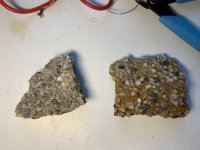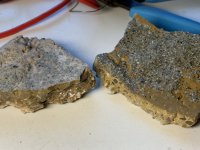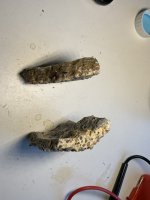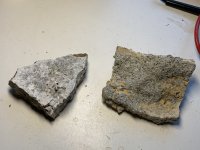Anything to add? Did you add any color, sand or admixures? Would you change anything if doing it again?
Since my post I have pebbled our spa myself, and had our pool professionally repebbled, and watched two pools get pebbled. The spa worked fine, and I was considering doing the pool, but it would have taken me too long to do myself.
I didn’t add colour but it is common to add oxides to white cement to adjust the colour.
I didn’t add admix, but PVA admix is common in the undercoat , (more below)
The basic mix in Australia tends to be 2 pebble to 1 white (or off white) cement. Different pebble crews tweak it slightly depending, but that’s the basic ratio.
The pros tend to do an undercoat/bondcoat which is a wet broomable mix of cement, water, coarse sand or pebble, and lots of PVA (despite these products forbidding use in pools). This provides a sticky rough “key” for the final coat. They mix this in big rubber tubs with “egg beater” style mixers and slop it on with soft brooms. They let this set for a day or two. The PVA seems to prevent this thin mix from drying and flaking off too quickly.
Different applicators mix and apply the main coat differently. In Australia is it done fairly manual. Some applicators dump all the dry material in the shallow end of pool, add water and mix with shovels into one big pile, then trowel it up the walls. Others use a standard cement mixer and do batches, which they dump into the pool as they go.
Once it’s troweled on and hard enough they expose the pebbles with a gerni with fan head, followed by acid wash.
It’s a bit of an art to doing the gerni. If it’s too soon it all falls apart when you spray it. Too late and the cement is too hard to wash off. If not dove evenly you get very inconsistent pebble exposure.
When doing the spa I used sponges to reveal pebbles, and acid wash, which is easier to control, but not as fast as gerni. Foam paint rollers are common too to expose pebbles.
Spray application of the pebble mix is less common in Australia. In America it’s more common I believe. A pebble applicator told me in America they use a richer 1:1 ratio, and spray it on, and that they wash out more of the cement during pebble exposure. In any case I can assure you 2:1 works when mixed and applied manually.
Pros use calcium chloride accelerator to speed up the set time, so they can apply and expose in a controlled time period.
They also sometimes use air entraining agents to aid workability.
They also use polymer admix when using glass beads, to help it stick together properly. Eg here:
Learning Library
You don’t use sand, except in the undercoat to add a rough key. You can use pebbles in the undercoat in the same way, it’s just that sand is cheaper.
All in all, it only needs to be pebble and cement on suitable substrate.





